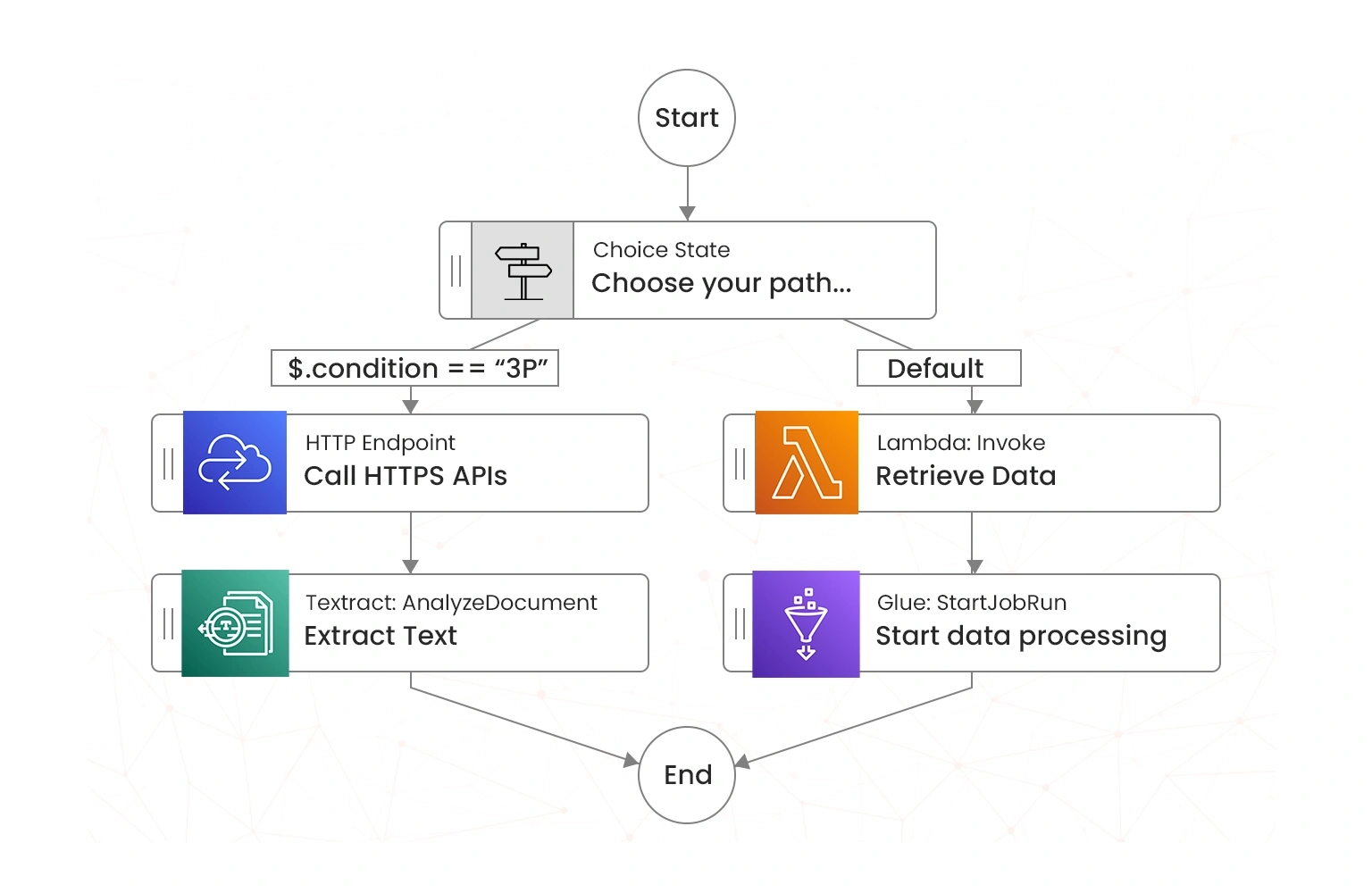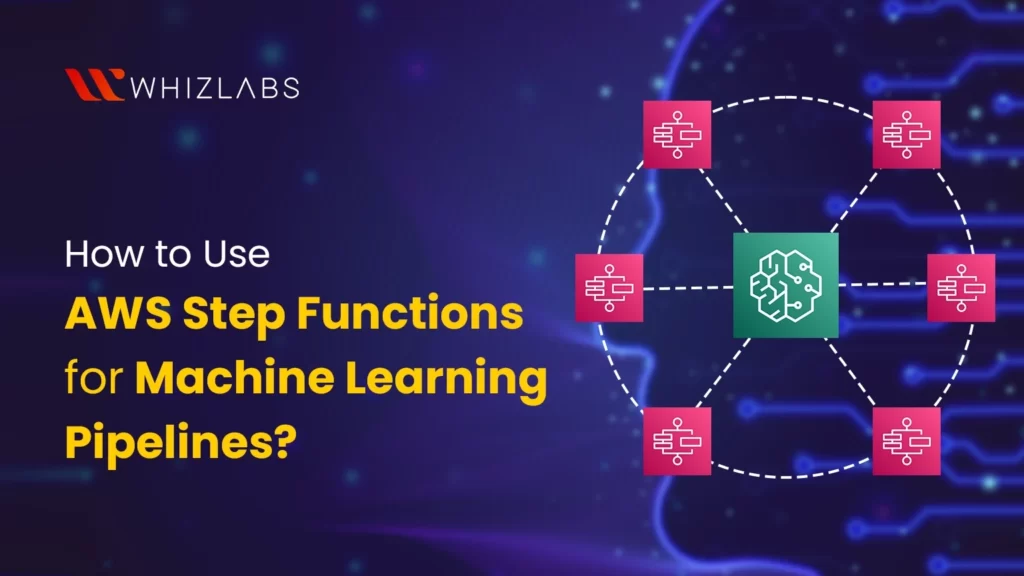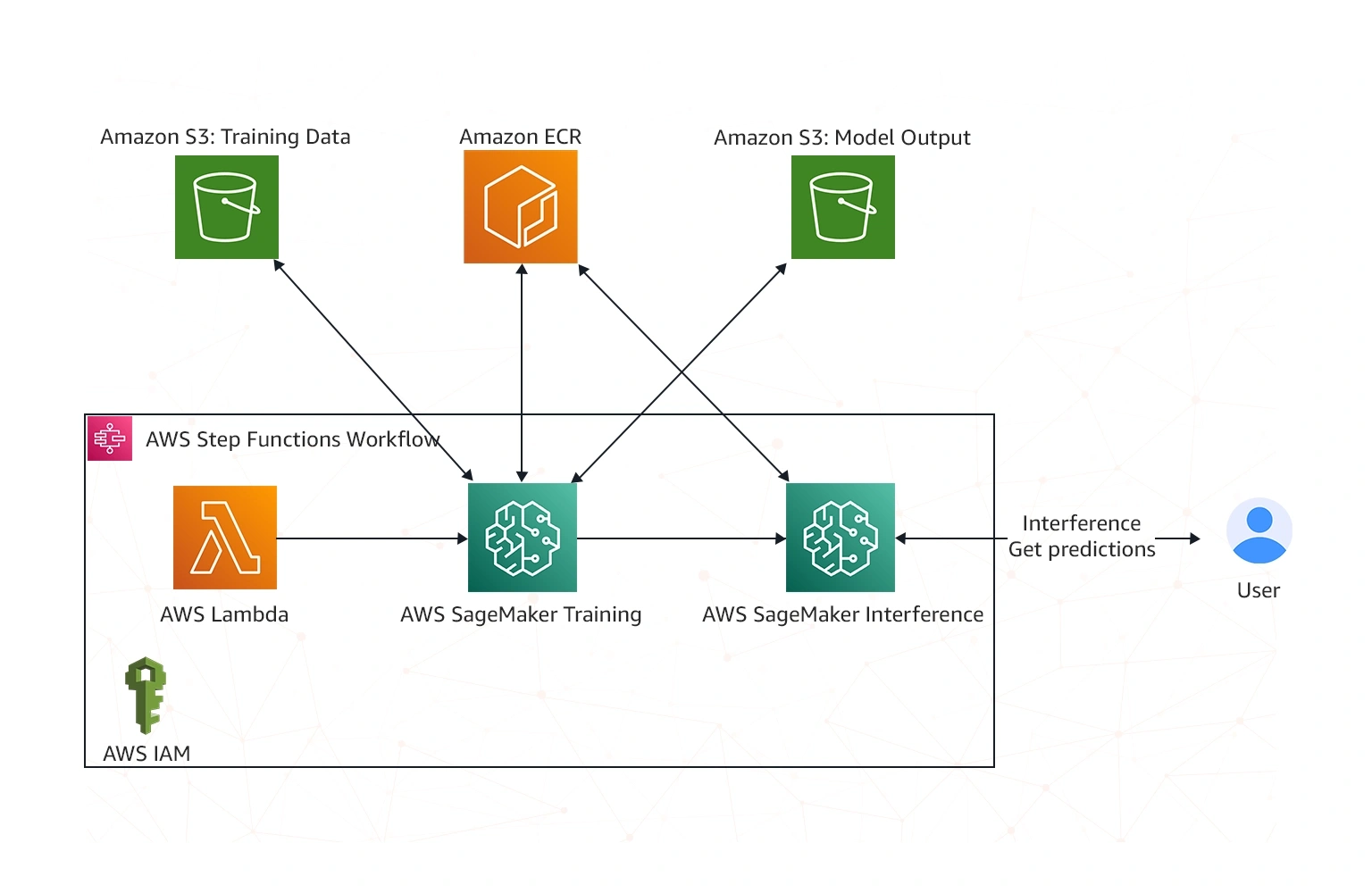AWS Step Functions play a vital role in machine learning (ML) pipelines. It is quite dominant in terms of embedded capabilities, workflows, integrations, and use cases with AWS. This blog explores how developers can use AWS Step Functions for machine learning pipelines and to integrate with AWS services. Here we will also cover the aspects of the AWS Certified Machine Learning Associate Certification (MLA-C01) exam that is important to get certified.
What are AWS Step Functions?
AWS Step Functions is a low-code, serverless orchestration service provisioned in AWS. The functionality uses state machines to coordinate distributed applications and automate processes. This makes it ideal for the automation of ML pipelines. With AWS Step Functions, developers can define workflows that execute ML tasks in a structured, event-driven manner. The diagram below shows a typical AWS workflow.

Benefits of AWS Step Functions
As a candidate preparing for the AWS Certified Machine Learning Associate Certification (MLA-C01) exam, you should be able to explain the benefits of the application of AWS Step Functions for ML pipelines.

- Serverless: The application of AWS Step Functions for ML pipelines reduces operational overhead by managing infrastructure. The serverless machine learning pipeline setup makes the functionality a cheap alternative for the management of ML pipelines.
- Simplifies ML pipeline development: AWS Step Functions can create data and ML pipelines, integrate with SaaS applications, build generative AI applications, and automate IT security and processes.
- Scalability: AWS Step Functions easily scale ML workloads by integrating various AWS services, data-related tools and even the AWS SDK itself. It can be used as an “orchestrator of orchestrators,” managing ML pipelines by splitting your workflow into smaller ones.
- Reliability: The functionality comprises built-in exception and error handling, retries, rollback, and state management capabilities. It can also orchestrate the entire machine learning workflow, not just model building.
- Ease of integration: AWS Step Functions connects seamlessly with AWS Lambda, Amazon SageMaker, and other AWS services. Developers can build robust business workflows, data pipelines, or apps using AWS resources from more than 200 services, including Lambda, ECS and SageMaker.
- Monitoring capabilities: The functionality provides robust tracking of execution state and logs for debugging. Developers can keep track of the state management, checkpoints, and restarts so that your workflows proceed as planned.
AWS Step Functions Use Cases in ML
The following is a brief explanation of the important use cases for AWS Step Function in AL model deployment
- Event-driven ML workflows: You can use AWS Step Functions to trigger workflows based on predefined events. Event-driven ML workflows are triggered by specific events, such as data updates or new training requests.
- ML model training automation: With AWS Step Functions, set up workflows that periodically retrain models using the latest data in S3.
- End-to-end pipeline automation: Developers can combine AWS Glue, SageMaker, and Lambda in Step Functions to create fully automated pipelines.
- Serverless ML pipelines: AWS Step Functions enable serverless execution, reducing operational overhead while scaling on demand.
- Data enrichment: AWS Step Functions is also used in data enrichment processes as part of preprocessing to provide better training data for more accurate ML models. It can also be used to annotate text and audio excerpts to add syntactical information, such as sarcasm.
- Microservice orchestration: AWS Step Functions gives you options to manage your microservice workflows. It allows you to break applications into loosely coupled services whilst permitting the use of a variety of programming languages and frameworks.
Steps for Creating an AWS ML Pipeline Using AWS Step Functions
MLA-C01 candidate should have an appreciation of the steps to be followed when creating ML pipelines using AWS Step Functions, which generally includes the following;
- Step 1: Data ingestion: Ingest data from Amazon S3. Using AWS Glue or AWS Lambda to fetch and preprocess data.
- Step 2: Preprocessing: Also called feature engineering, this step involves processing and transforming data for training. Use AWS Lambda for feature extraction.
- Step 3: Model training: Trigger Amazon SageMaker to train models using the prepared dataset and built-in or custom algorithms. Amazon SageMaker is AWS’s managed ML platform, and integrating it with AWS Step Functions allows you to automate ML workflows.
- Step 4: ML model evaluation: Validate model performance using automated metrics There is need to evaluate performance metrics such as accuracy and F1 score. You can use SageMaker to tune the hyperparameters of a machine learning model, and to batch transform a test dataset.
- Step 5: ML pipeline deployment: Deploy the trained model to Amazon SageMaker endpoints seamlessly for inference. Ensure that you deploy custom ML models using service integrations between AWS Services and CI/CD pipelines.
- Step 6: ML pipeline monitoring and logging: Monitor models post-deployment with AWS CloudWatch and Step Functions’ logging features. Enable AWS CloudWatch to log and monitor model performance over time.
Leveraging AWS Lambda for ML Orchestration
AWS Lambda is a serverless compute service that integrates well with AWS Step Functions for ML orchestration. AWS Lambda functions are executed on demand, making them an efficient choice for lightweight ML tasks within Step Functions workflows. The key takeaway to note here is that Step Functions starts an AWS Lambda function, generating a unique job ID.
The following represent the benefits of integrating AWS Step Functions with AWS Lambda in ML pipelines:
- Custom preprocessing: Developers can use AWS Lambda to clean, transform and prepare data before training.
- Task orchestration: You can automate transitions between training and evaluation tasks and trigger different stages of the ML pipeline.
- Cost optimisation: Serverless execution of AWS Lambda ensures that you only pay for what you use. Optimised integrations provide custom options to use these services on your state machines.
- Custom post-processing: AWS Lambda is also useful in carrying out post-processing predictions and handling inference results.
Amazon SageMaker Integration with AWS Step Functions
AWS Step Functions integrates seamlessly with Amazon SageMaker, a service tailored for end-to-end ML processes, as shown in the diagram below;
Integrating AWS Step Functions with Amazon SageMaker provides key benefits in the deployment of ML pipelines. These include the following;
- Model training automation: Developers can use Amazon SageMaker’s pre-built algorithms or bring their models in the development environment.
- Hyperparameter optimisation: Amazon SageMaker provides automated tuning for optimal model performance. This leads to enhanced model performance overall.
- Model deployment: Amazon SageMaker can be used to deploy models as scalable endpoints directly from workflows.
Best Practices for Secure and Scalable Pipelines
- Secure Your Data
By encrypting data at rest and in transit, you secure the data, and you can also mask or anonymise sensitive data in the flow. - Modular and Reusable Components
By designing reusable ETL/ML steps with containers and Lambda Functions. It parameterises workflow with flexibility and scale. - Infrastructure Scaling
using auto scale services like AWS Batch, SageMaker pipelines, or Lambda, which monitor cost and resource utilisation with Cloud Watch and Cost Explorer. - Error Handling and Retry Logic
It implements a fail-safe mechanism using Step functions that are built in for retry and catch patterns. - Auditability and Logging
Integrating CloudTrail, CloudWatch Logs, Step Functions, and other tools helps with stating logging compliance and traceability.
Why Does AWS Step Functions Matter for MLA-C01 Certification?
- The step function-orchestrated ML workflow automates model training, evaluation and deployment.
- The native AWS Orchestration tool makes highly testable exam scenarios focusing on Scalability and repeatability in the ML pipeline.
Mapping Step Function Concepts To MLA-C01 Exam Objectives.
| MLA-C01 Domain | Relevant Step Functions Usage |
| Data Engineering | Automate data ingestion and preprocessing pipelines |
| Exploratory Data Analysis | Triggers parallel data check and feature engineering tasks. |
| Modeling | Constructus training jobs |
| Machine Learning Implementation & Ops | Automates deployment, monitoring and retraining flow. |
What in the real world do we do that’s relevant to MLA-C01 Certification?
- Automate SageMaker training and batch transform jobs
- Handle model drift detection and retraining workflows
- Integrating with Lambda to trigger alerts or Slack notifications
- Create branch logic based on model accuracy or validating output
Conclusion
As discussed in this blog, AWS Step Functions, an important part of the AWS machine learning services, play a vital role in building and deploying scalable, automated, and serverless machine learning pipelines. It also integrates well with other AWS services, principally AWS Lambda and Amazon SageMaker, to simplify the orchestration of complex ML workflows. Concepts discussed in this blog allow you to adequately prepare for the AWS Certified Machine Learning Associate Certification exam. Our practice tests, Sandboxes, Hands-on Labs and video courses can truly be a great addition to your preparation resource, and we do support our learners with complete assistance. So what more? Get started now!
- How to Prepare for SAP-C02 After AWS Associate? - December 10, 2025
- Complete Overview of Microsoft AB-900, AB-730, AB-731, AB-100 - December 3, 2025
- Step-by-step guide to prepare AWS AIF-C01 in 2025 - November 3, 2025
- 7 Reasons to Get Scrum Master Certification in 2025 - September 30, 2025
- Top Microsoft Azure Courses to Learn in 2025 - September 17, 2025
- Top Cloud Computing Courses to Learn in 2025 - September 10, 2025
- How to Pass the GH 900 GitHub Foundation in 2025? - August 6, 2025
- Salesforce Agentforce Passing Guide and Career Roadmap - July 10, 2025





